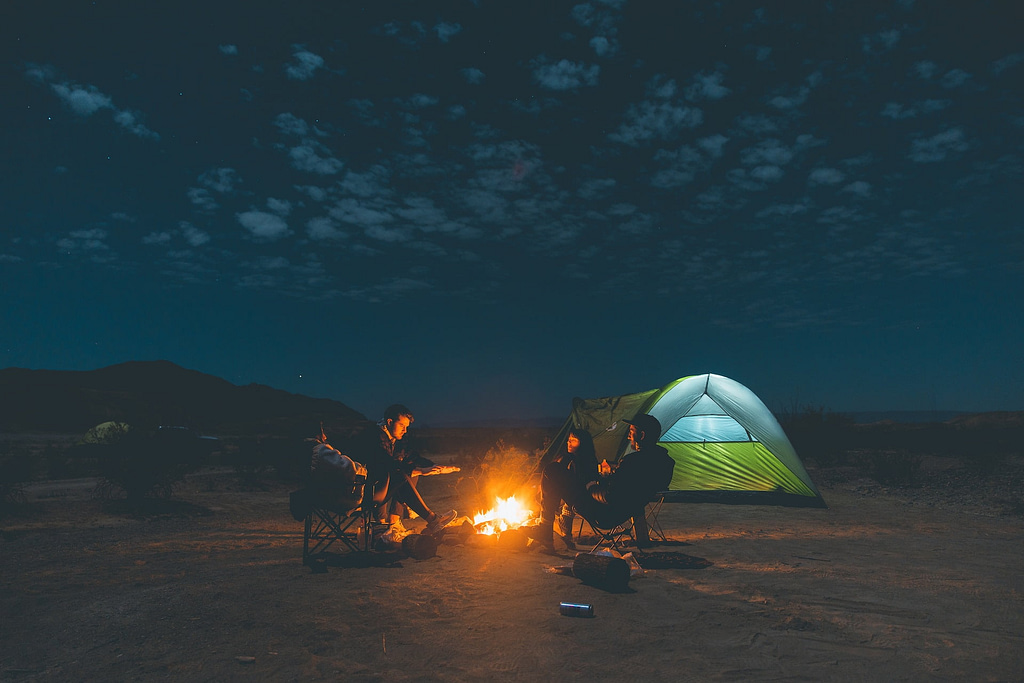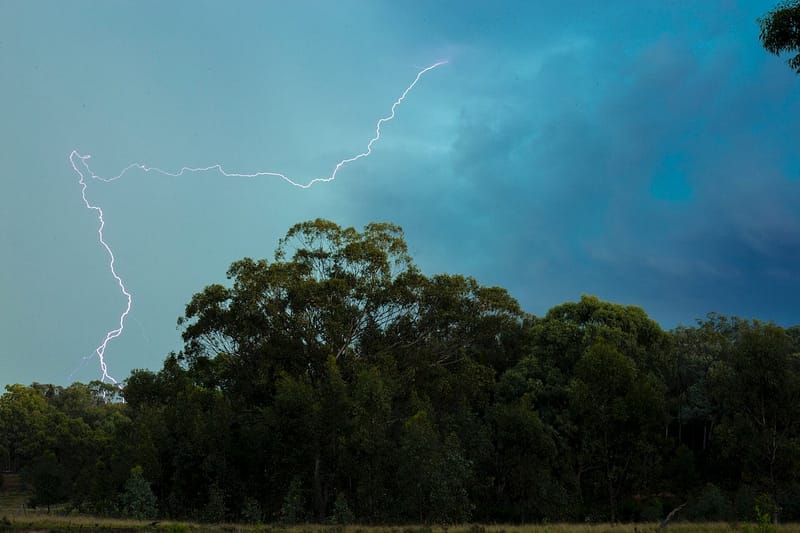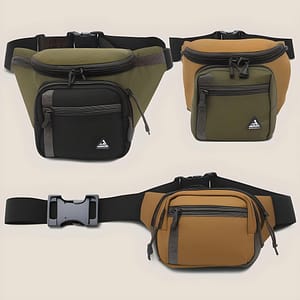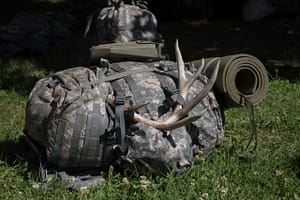Sometimes, One of the things that make the experience in nature fun is dealing with the forces of nature. Some of us enjoy this experience similar to an athlete who runs a half marathon and despite the physical and mental difficulty he continues to run because of the satisfaction of dealing with difficulties. For some of us, camping in harsh weather is a dubious experience and the preference is to avoid it. Either way, sometimes we experience sudden changes in the weather that we have to adapt to.
One of the challenging weather phenomena are thunderstorms. Thunderstorms are a common occurrence during the summer and spring months In some places (along the Gulf Coast and across the southeastern and western states) and in the winter in other (South Europe), and knowing how to handle them while camping is crucial for your safety. In this blog, we will discuss essential tips on preparing for a thunderstorm camping, staying safe during one, emergency preparedness, and what to do after the storm has passed.
How often do thunderstorms occur while camping?

Thunderstorms occur frequently while camping, with the frequency depending on the location and time of year. Camping in areas that experience more severe weather patterns, such as mountainous regions or coastal areas, may increase the likelihood of encountering thunderstorms.
While it is difficult to provide an exact frequency, thunderstorms can occur as often as a few times per month in certain regions. However, it is important to note that thunderstorms can be highly localized, meaning that they may only affect specific areas while leaving others untouched. Therefore, the frequency of thunderstorms experienced while camping will vary depending on the specific campsite and its surrounding environment.
When planning a camping trip, it is advisable to research the historical weather patterns of the area to get an idea of the likelihood of thunderstorms occurring during the chosen time of visit. Local weather forecasts and alerts can also provide valuable information on potential thunderstorm activity. It is important to stay informed and prepared for thunderstorms while camping, as they can bring strong winds, heavy rain, lightning, and even hail, posing potential risks to campers and their equipment.
Preparing for a Thunderstorm

Did you know that thunderstorms can produce hailstones as large as baseballs, causing significant damage to property and crops?
1. Choose a Safe Location:
When setting up camp during a thunderstorm, it is crucial to select a safe location that minimizes the chances of lightning strikes. Avoid open fields, hilltops, and isolated tall trees as they attract lightning. Instead, opt for lower-lying areas or campsites in valleys, preferably surrounded by smaller trees or shrubs that can serve as natural lightning repellents.
2. Delay Setting Up:
If you cannot find immediate shelter, postpone setting up camp until the storm passes or at least until the intensity decreases. Lightning can strike even before rain starts falling, and it is crucial to avoid exposing yourself and your camping equipment to potential hazards.
3. Prepare for Rain:
Once the storm intensity decreases, it is important to prepare for rain to ensure a dry and comfortable camping experience. Here are some steps you can take to stay dry during a thunderstorm:
A. Use a Groundsheet: Place a groundsheet or tarp underneath your tent to create a barrier between the wet ground and the bottom of your tent. This will help prevent moisture from seeping into your tent from below.
B. Angle Your Tent: Set up your tent on slightly higher ground or on a slope to ensure that rainwater drains away from your tent. Avoid setting up your tent in low-lying areas where water can pool and potentially flood your tent.
C. Create a Rain Runoff: Dig a shallow trench around the perimeter of your tent to divert rainwater away from your campsite. This will help prevent water from accumulating around your tent and potentially causing leaks.
D. Use Waterproof Bags: Store your belongings in waterproof bags or dry sacks to protect them from getting wet. Invest in high-quality waterproof bags that are specifically designed for outdoor activities. Look for bags made from durable materials such as PVC or nylon, with sealed seams to prevent any water from seeping inand damaging your items.
4. Secure Your Tent:
To ensure that your tent stays in place during a thunderstorm, it is essential to secure it properly. Use sturdy stakes to anchor your tent to the ground and prevent it from being blown away bystrong winds. Here are some tips for securing your tent:
A. Use Tent Stakes: Make sure to use strong, durable tent stakes that are appropriate for the terrain you are camping on. Hammer the stakes into the ground at a 45-degree angle, ensuring they are firmly anchored.
B. Use Guy Lines: Attach guy lines to the corners of your tent and secure them to nearby trees or rocks. This will provide extra stability and prevent your tent from collapsing in strong winds.
C. Reinforce Tent Poles: Check the tension of your tent poles and make sure they are properly secured. If necessary, use additional guylines or straps to reinforce the structure of your tent.
D. Remove Loose Items: Before the storm hits, remove any loose items from around your tent that could be blown away or cause damage. This includes camping chairs, cooking equipment, and any other items that are not securely tied down.
Tips for Staying Safe While Camping During a Unpredictable Thunderstorm

Stay inside your tent during a thunderstorm to stay safe from lightning strikes. Seek shelter in a sturdy, well-grounded building if available. Avoid tall objects and bodies of water, as these can attract lightning. Take caution and do not take shelter under a tree, as they are more prone to being struck by lightning.
Stay inside your tent
Secure your tent properly to ensure it stays intact during a thunderstorm. Use sturdy stakes and tie-downs to anchor the tent securely to the ground. Avoid touching the sides of the tent, as this can increase your risk of getting wet or injured if lightning strikes nearby. Additionally, keep all metal objects away from the walls of your tent, as these can act as conductors for electricity during a storm.
Remember: safety is paramount when camping in a thunderstorm! Stay inside your tent, secure it properly, avoid touching its sides and keep all metal objects at a safe distance from its walls. Following these essential tips will help minimize risks and ensure you stay safe until the storm subsides.
Avoid tall objects and bodies of water
In the midst of a thunderstorm camping, it is crucial to take precautions and avoid tall objects and bodies of water. Here are some essential tips to keep in mind:
- Move away from open areas: Seek shelter in a more enclosed space to minimize your exposure to lightning strikes.
- Find lower ground if possible: Lower elevations provide greater safety during a storm.
- Stay clear of rivers, lakes, or any body of water: Water conducts electricity, making it dangerous during a thunderstorm.
By following these guidelines, you can significantly reduce the risks associated with being near tall objects and bodies of water during a thunderstorm.
Don’t take shelter under a tree
Look for a low-lying area instead. During a thunderstorm, avoid taking shelter under trees and find a lower area to stay safe from lightning strikes.
Find natural shelters like rocky outcrops or caves. Instead of seeking refuge under trees, look for natural formations such as rocky outcrops or caves that can provide better protection during a thunderstorm.
Stay at least twice as far from trees as their height. To reduce the risk of being struck by lightning, maintain a safe distance from trees by staying at least twice their height away.
Emergency Preparedness
Pack a well-stocked first aid kit with essential items such as bandages, antiseptic wipes, and pain relievers. In case of any injuries or accidents during a thunderstorm camping, you’ll have the necessary supplies to provide immediate medical care.
Don’t forget to bring a reliable flashlight and extra batteries. A sudden power outage during a storm can leave you in complete darkness, making it difficult to navigate your campsite. Having a strong source of light will ensure your safety and help you find your way around.
Familiarize yourself with the emergency procedures specific to your campsite or campground. Knowing where the nearest shelter is located and what actions to take during severe weather conditions will enhance your preparedness and decrease the risk of injury or harm.
Pack a first aid kit
Include bandages, antiseptic ointment, and pain relievers to ensure you’re prepared for any minor injuries that may occur during your camping trip. Don’t forget to pack any necessary prescription medications in case of emergencies. Consider including insect repellent and sunscreen to protect yourself from bites and sunburn while exploring the great outdoors.
Bring a flashlight and extra batteries
Choose a durable waterproof flashlight that can withstand the elements and provide reliable illumination during a thunderstorm. Opt for one with adjustable brightness settings for different needs. Don’t forget to pack spare batteries in case of a prolonged power outage, ensuring you have enough backup power to last throughout your camping trip. Additionally, include an additional headlamp in your gear for hands-free use, allowing you to navigate through the stormy weather while keeping both of your hands free.
Know the emergency procedures
- Familiarize yourself with the campground’s emergency protocols. It is crucial to be aware of the procedures in place to handle emergencies and ensure your safety.
- Identify the nearest shelter or designated safe areas on-site. Take note of where you can seek refuge during a thunderstorm or severe weather conditions.
- Learn how to recognize signs of severe weather. Being able to identify indications such as darkening skies, strong winds, and distant thunder will allow you to take prompt action and find shelter immediately if necessary.
- Familiarize yourself with the campground’s emergency protocols.
- Identify the nearest shelter or designated safe areas on-site.
- Learn how to recognize signs of severe weather.
Pack Extra Food and Water
During a thunderstorm, it’s important to have extra food and water in case you get stuck in your tent for an extended period. Pack non-perishable food items that are easy to prepare and require minimal cooking. Granola bars, canned goods, and dried fruits are all great options. Additionally, bring enough water to last for at least 72 hours, as power outages or contaminated water sources may make it difficult to access clean water.
Additional Specific Items You Should Include in Your Gear When Camping in a Thunderstorm
1. Weatherproof Tent:
Investing in a high-quality, weatherproof tent is the first step in ensuring your safety during a thunderstorm. Look for a tent that is designed to withstand heavy rain, strong winds, and thunderstorms. Consider features such as a robust rainfly, sturdy poles, and a waterproof floor. Additionally, make sure your tent is properly pitched on higher ground to minimize the risk of flooding.
2. Weatherproof Sleeping Bag:
In addition to a weatherproof tent, a weatherproof sleeping bag is essential for camping in a thunderstorm. Look for a sleeping bag that is made with waterproof or water-resistant materials. This will help to keep you dry and insulated even if your tent leaks or becomes flooded. Consider a sleeping bag with a hood to provide extra protection for your head during heavy rain or wind. It’s also a good idea to bring a waterproof stuff sack to protect your sleeping bag from getting wet during transport or if you need to store it outside your tent during the storm.
3. Waterproof Rainfly and Groundsheet:
A waterproof rainfly is essential to protect your tent from rainfall and prevent water from seeping in through the mesh or seams. Ensure that your tent comes with a rainfly specifically designed for heavy rain and strong winds. Some tents even have integrated rainflys, which provide added convenience and ease of use.
A waterproof groundsheet or footprint is another crucial item to include. Placing this underneath your tent will provide an extra layer of protection against groundwater and prevent moisture from seeping into your sleeping area.
4. Secure Tent Stakes:
To ensure your tent stays in place during strong winds, invest in secure tent stakes. Look for stakes that are sturdy and durable, such as ones made from aluminum or steel. Additionally, consider purchasing stakes with a spiral shape or hooks, as these provide added stability in soft or sandy ground. It’s also a good idea to bring extra stakes in case any get lost or damaged during the storm.
5. Guylines or Ropes:
Guylines or ropes are an essential part of securing your tent during a thunderstorm. These lines help to stabilize the tent and prevent it from collapsing or being blown away by strong winds. Make sure to pack enough guylines or ropes to secure all the corners and sides of your tent. Look for high-quality, durable ropes that are resistant to stretching and snapping. It’s also important to learn how to properly tie knots for maximum security.
6. Battery-powered Weather Radio:
A battery-powered weather radio is a crucial item to have when camping in a thunderstorm. This device will keep you informed about any severe weather updates or warnings in your area. Look for a weather radio that is portable and easy to use. Make sure to pack extra batteries to ensure continuous operation during an extended storm.
7. Sleeping Pad:
A sleeping pad is an important item to include in your gear when camping in a thunderstorm. Not only does it provide cushioning and insulation for a comfortable night’s sleep, but it also serves as a barrier between you and the wet ground. Look for a sleeping pad that is waterproof or has a water-resistant coating to ensure it stays dry even in heavy rain. Additionally, consider a pad with insulation properties to keep you warm during colder nights. Choose a sleeping pad that is lightweight and easy to pack, making it convenient to carry on your camping trips.
Clothing items that are recommended for camping in a thunderstorm?
Camping in a thunderstorm can be an exhilarating and memorable experience, but it is important to prioritize safety and be prepared for adverse weather conditions. While there may not be specific clothing items designed solely for camping in thunderstorms, there are a few essential garments and gear that are highly recommended to ensure your safety and comfort.
1. Rain Gear:
Investing in high-quality rain gear is essential when camping in a thunderstorm. Opt for a waterproof and breathable rain jacket and pants to protect yourself from getting wet. Look for products with sealed seams and adjustable cuffs to prevent water from seeping in. Additionally, consider wearing a rain hat or a waterproof hat with a wide brim to keep rain off your face.
2. Layered Clothing:
To drees in layers is crucial when camping in any weather condition, including thunderstorms. Start with a moisture-wicking base layer that will keep you dry by pulling sweat away from your body. Next, add an insulating layer such as a fleece or down jacket to retain body heat. Finally, top it off with a waterproof outer layer to shield you from rain and wind. This layering system allows you to adjust your clothing according to the changing weather conditions during the thunderstorm.
3. Quick-Drying Fabrics:
Choose clothing items made from quick-drying fabrics, such as nylon orpolyester, to ensure that you stay dry even if you get caught in a downpour. These fabrics have the ability to wick away moisture from your skin and dry quickly, preventing discomfort and chafing. Avoid cotton clothing, as it tends to absorb and retain moisture, which can make you feel cold and damp.
4. Waterproof Footwear:
Invest in a pair of waterproof hiking boots or shoes to protect your feet from getting wet and cold. Look for footwear that has a waterproof membrane, such as Gore-Tex, which provides excellent protection against water while still allowing your feet to breathe. Additionally, consider wearing gaiters to cover your ankles and lower legs for added protection against rain and mud.
5. Headlamp:
A reliable headlamp is an essential item to have when camping in a thunderstorm. It provides hands-free illumination and allows you to navigate through the dark, especially if the storm causes a power outage. Look for a headlamp with a waterproof rating and adjustable brightness settings to suit your needs.
How do you set up camp in a thunderstorm?

1. Choose a Safe Location:
When setting up camp during a thunderstorm, it is crucial to select a safe location that minimizes the chances of lightning strikes. Avoid open fields, hilltops, and isolated tall trees as they attract lightning. Instead, opt for lower-lying areas or campsites in valleys, preferably surrounded by smaller trees or shrubs that can serve as natural lightning repellents.
2. Delay Setting Up:
If you cannot find immediate shelter, postpone setting up camp until the storm passes or at least until the intensity decreases. Lightning can strike even before rain starts falling, and it is crucial to avoid exposing yourself and your camping equipment to potential hazards.
3. Prepare for Rain:
Once the storm intensity decreases, it is important to prepare for rain to ensure a dry and comfortable camping experience. Here are some steps you can take to stay dry during a thunderstorm:
A. Use a Groundsheet: Place a groundsheet or tarp underneath your tent to create a barrier between the wet ground and the bottom of your tent. This will help prevent moisture from seeping into your tent from below.
B. Angle Your Tent: Set up your tent on slightly higher ground or on a slope to ensure that rainwater drains away from your tent. Avoid setting up your tent in low-lying areas where water can pool and potentially flood your tent.
C. Create a Rain Runoff: Dig a shallow trench around the perimeter of your tent to divert rainwater away from your campsite. This will help prevent water from accumulating around your tent and potentially causing leaks.
D. Use Waterproof Bags: Store your belongings in waterproof bags or dry sacks to protect them from getting wet. Invest in high-quality waterproof bags that are specifically designed for outdoor activities. Look for bags made from durable materials such as PVC or nylon, with sealed seams to prevent any water from seeping in
What should you do if your tent is struck by lightning while camping in a thunderstorm?
Camping in a thunderstorm can be a frightening and potentially dangerous experience, especially if lightning strikes your tent. While it is rare for lightning to directly strike a tent, it is important to know what to do to ensure your safety. Here are the steps you should take if your tent is struck by lightning while camping in a thunderstorm:
1. Stay Calm and Assess the Situation: The first and most crucial thing to do is to remain calm. Panicking can cloud your judgment and hinder your ability to make rational decisions. Assess the situation and determine if you or anyone else in the tent has been injured.
2. Check for Injuries: If anyone in the tent is injured, administer first aid as necessary. If the injuries are severe or life-threatening, immediately call emergency services or seek medical help if available. Remember, your safety and the safety of others is the top priority.
3. Exit the Tent Safely: If no injuries are apparent, carefully exit the tent. Avoid touching the tent’s walls or poles and move away from the tent as quickly as possible. Metal tent poles can conduct electricity, so it is essential to create distance between yourself and the tent to reduce the risk of injury.
4. Seek Medical Attention: Even if no injuries were apparent at the time of the lightning strike, it is still advisable to seek medical attention. Lightning strikes can cause internal injuries that may not be immediately apparent. It is better to be safe and get checked by a medical professional.
What to Do After the Storm

Wait Out the Storm: Once you have found a safe shelter, wait for the storm to pass. Lightning can continue to strike even after the storm has seemingly moved away, so it is important to stay in a safe location until the threat has completely passed.
Check for damages: After a thunderstorm, it is important to thoroughly inspect your camping equipment and surrounding area for any damages. Check for leaks in your tent, broken poles, or any other signs of wear and tear. Additionally, survey the campsite for fallen branches or debris that could pose a safety hazard.
Clean up and dry your gear: Once you have assessed any damages, take the time to clean and dry your camping gear. Wipe down wet surfaces with a towel or cloth and hang up damp items to air dry. This will help prevent mold or mildew from forming on your equipment.
Stay updated on weather conditions: Even after the storm has passed, it is crucial to stay informed about future weather conditions. Monitor local forecasts and pay attention to any warnings issued by authorities. Be prepared to make necessary adjustments to your plans if there are indications of more severe weather approaching.
Check for damages
Inspect your tent for tears or leaks. Look for any signs of damage that could compromise its waterproofing abilities during a thunderstorm. Check the condition of your camping equipment to ensure it is in working order and won’t fail when you need it most. Examine nearby trees and branches for potential hazards, as they can pose a risk if they are weak or unstable in high winds. Stay cautious and mitigate any risks before settling in.
Clean up and dry your gear
Remove any dirt, debris or standing water from your campsite. A thorough clean-up will prevent further damage to your gear and ensure a safer camping experience. Dry out wet clothes and sleeping bags as soon as possible to avoid mildew and unpleasant odors. Clean and sanitize cooking utensils before using them again to eliminate any potential contamination from the storm. Taking these preventive measures will help you maintain the longevity of your gear while keeping yourself safe during future outdoor adventures.
Remember, camping in a thunderstorm can be extremely dangerous. It is always best to monitor weather conditions beforehand and avoid camping if severe weather is forecasted. If you do find yourself in a thunderstorm while camping, follow these steps to ensure your safety.





